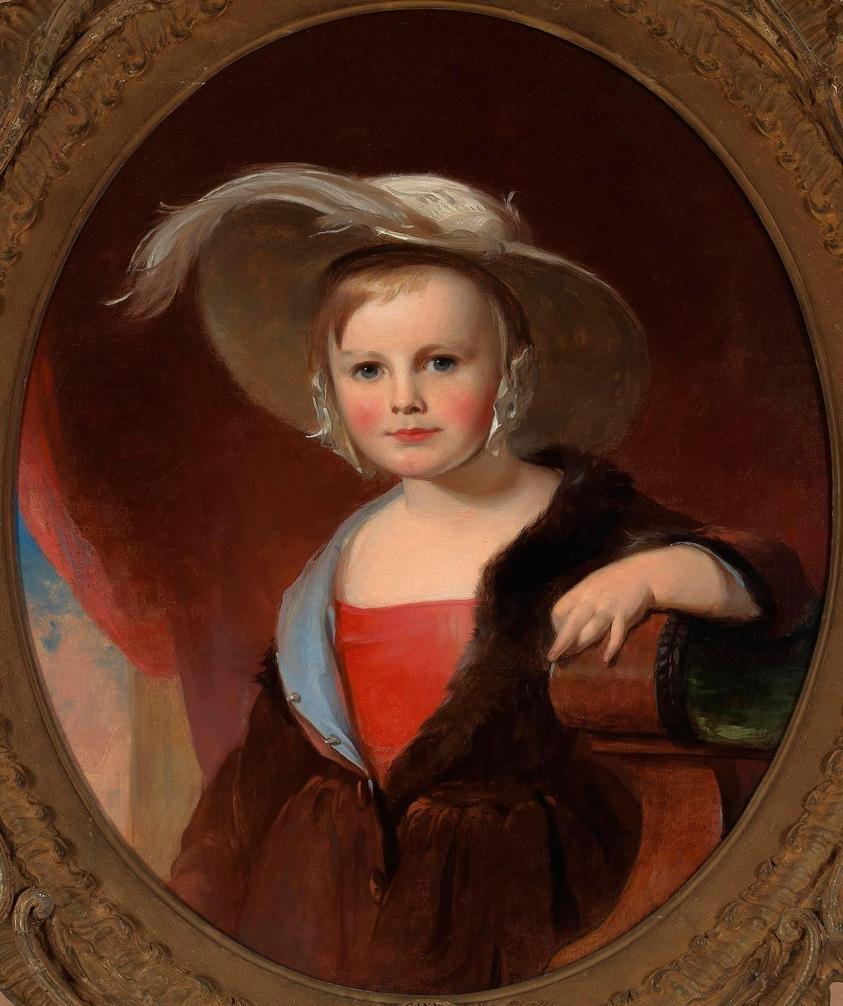
Artist:
Thomas Sully
(American, 1783 - 1872)
Sitter:
Horace Binney Hare
Horace Binney Hare
Medium: Oil on canvas
Date: 1847-1848
Dimensions:
30 × 25 in. (76.2 × 63.5 cm)
Accession number: 2005.4.3
Label Copy:
How boys’ fashions have changed! The young Horace Binney Hare—a grandson to Robert Hare, and a great grandson to Martha Harford Hare—comes from a family with a tradition of hiring the greatest portrait painters to capture their likenesses. The dress-like tunic and large plumed hat were probably a little old-fashioned even in the 1840s when this portrait was made. Considering that the portrait was for the older members of his family to enjoy, it is not surprising that he is dressed in the costume of their youth.
How boys’ fashions have changed! The young Horace Binney Hare—a grandson to Robert Hare, and a great grandson to Martha Harford Hare—comes from a family with a tradition of hiring the greatest portrait painters to capture their likenesses. The dress-like tunic and large plumed hat were probably a little old-fashioned even in the 1840s when this portrait was made. Considering that the portrait was for the older members of his family to enjoy, it is not surprising that he is dressed in the costume of their youth.
Curatorial RemarksArtist Thomas Sully captures Horace Binney Hare (1843-1879) as a pink-cheeked youth wearing a dashing hat trimmed with a white feather. With soulful, expressive eyes, he gazes directly into the middle distance, while his closed lips give a suggestion of a smile. The vitality of the sitter's face, glance and posture make this work very appealing.
Horace Binney Hare was the eldest son of Judge Innis Clark Hare and Esther Cox Binney. He left Harvard College to join the Union Army as a cavalryman. After the Civil War, he was graduated from Medical School at the University of Pennsylvania in 1866. Following in the footsteps of his grandfather, Robert Hare, II, he became professor of chemistry and chairman of the department. He met and married Emily Power Beale, daughter of Thomas Truxtun Beale and Mary (Tillinghast) Beale and granddaughter of Commodore Thomas Truxtun. They had four children: C. Willing, Esther Binney, Horace Binney, and Thomas Truxtun Hare. The latter was a lawyer, author of numerous books for young people, and former All-American football player at the University of Pennsylvania. Dr. Horace Binney Hare died prematurely in St. Thomas, Virgin Islands, at the age of thirty-six. His early death was caused by tuberculosis contracted during his service in the Civil War.
Horace Binney Hare was the eldest son of Judge Innis Clark Hare and Esther Cox Binney. He left Harvard College to join the Union Army as a cavalryman. After the Civil War, he was graduated from Medical School at the University of Pennsylvania in 1866. Following in the footsteps of his grandfather, Robert Hare, II, he became professor of chemistry and chairman of the department. He met and married Emily Power Beale, daughter of Thomas Truxtun Beale and Mary (Tillinghast) Beale and granddaughter of Commodore Thomas Truxtun. They had four children: C. Willing, Esther Binney, Horace Binney, and Thomas Truxtun Hare. The latter was a lawyer, author of numerous books for young people, and former All-American football player at the University of Pennsylvania. Dr. Horace Binney Hare died prematurely in St. Thomas, Virgin Islands, at the age of thirty-six. His early death was caused by tuberculosis contracted during his service in the Civil War.